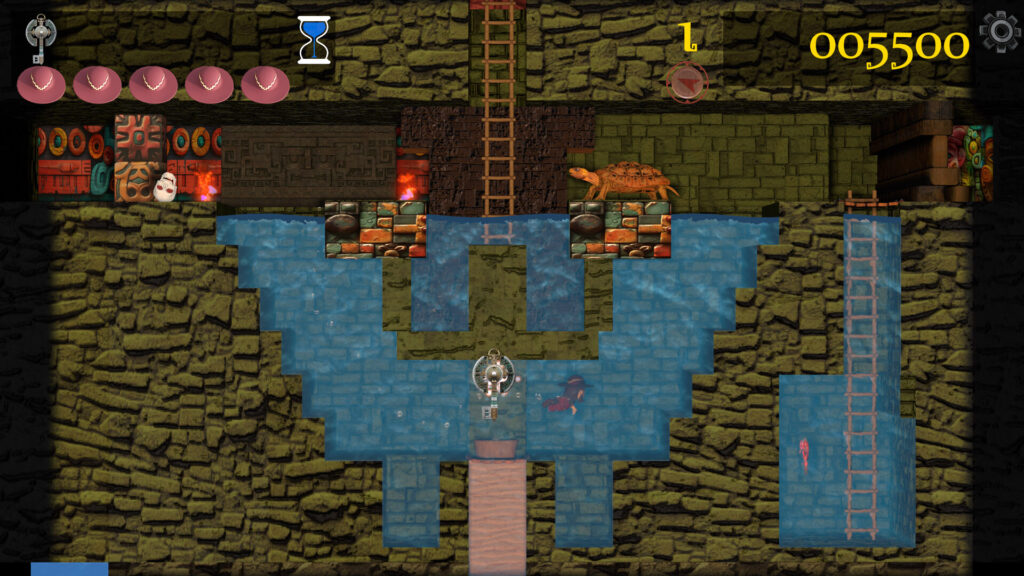A Classic Reborn—or Stuck in the Past?
Montezuma’s Revenge is one of the most influential platformers from the early 1980s, often credited as a precursor to the Metroidvania genre. Now, four decades later, Montezuma’s Revenge: The 40th Anniversary Edition attempts to bring the classic back to life with a fresh 2.5D coat of paint and expanded content. However, while the game aims to preserve its roots, it does so to a fault, failing to modernize the mechanics in a way that would make it enjoyable for today’s players.
Rather than refining the experience, this remake feels like a direct portal to 1984—complete with all the frustrating design choices that modern platformers have long since evolved past. Clunky physics, an unforgiving fall damage system, and a confusing level layout make it a tough sell for anyone other than the most hardcore nostalgia seekers.

A Look at the Gameplay: Stubbornly Authentic
At its core, Montezuma’s Revenge is a multi-room platformer where players take on the role of Pedro (or Rosita, his newly introduced sister) as they navigate 100 perilous chambers filled with traps, treasures, and enemies. The objective remains simple: collect artifacts, dodge dangers, and make it out alive.
While preserving the spirit of the original is commendable, the refusal to update basic mechanics results in a game that feels downright archaic. The movement and physics are stiff, making jumps feel unpredictable and frustratingly inconsistent. In an era where remakes like Metroid: Zero Mission and The Legend of Zelda: Link’s Awakening successfully modernized their respective classics, Montezuma’s Revenge: The 40th Anniversary Edition feels like a missed opportunity.
The most baffling design choice is the retention of fall damage—an unusual and unnecessary mechanic for a 2D platformer. Falling just a little too far punishes players in a way that feels unfair rather than challenging. Combine this with unresponsive controls and inconsistent collision detection, and you have a game that feels more like an endurance test than an exciting adventure.
Visual Upgrade or Visual Downgrade?
One of the biggest selling points of this remake is its new 2.5D graphical style, which attempts to bring the classic into a modern aesthetic. Unfortunately, the execution leaves much to be desired. While the environments have more detail, the character models and animations feel cheap and lack the polish expected from a proper remake.
Worse still, the updated visuals make navigation more confusing rather than intuitive. The original’s simplistic pixel art clearly conveyed platform edges and hazards, while the 2.5D perspective sometimes obscures important gameplay elements. Instead of enhancing the experience, the graphical overhaul introduces a new layer of frustration.
A Sound Design Misstep
Sound design is another major drawback. The game features excessive voice acting—primarily in Spanish—which might have been a charming addition if done well. However, the voice work is poorly delivered and quickly becomes repetitive, turning what could have been a unique cultural touch into an annoyance.
The music and sound effects also fail to add much to the experience. They feel generic and lack the atmospheric charm that a game like this needs to make exploration enjoyable. Given the amount of effort put into revamping the visuals, it’s disappointing that the audio design wasn’t given the same level of attention.
The Saving Grace: The Original ROM
Ironically, one of the best parts of this package is that it includes the original 1984 version of Montezuma’s Revenge. For purists who want to relive the game as it was originally designed, this inclusion is a nice touch. And in many ways, the ROM plays better than the remake—its simple pixel art and familiar mechanics feel more at home in their original form than in this awkward reimagining.
While it’s great to have access to gaming history, it raises an important question: if the original game is more enjoyable, then what’s the point of the remake?
Where It Falls Short (and Where It Succeeds)
What Keeps It from Treasure Status
- Unforgiving Gameplay That Hasn’t Aged Well – The rigid movement, fall damage, and lack of quality-of-life improvements make this game frustrating rather than nostalgic.
- Confusing Level Design – The layout is already difficult to navigate, but the new 2.5D perspective makes it even harder to determine where to go.
- Poor Optimization – The game suffers from frame rate drops and unresponsive controls, making an already difficult experience feel even worse.
- Annoying Sound Design – Overused, low-quality voice acting quickly grates on the ears, adding frustration rather than charm.
What It Does Right
- Includes the Original Game – For those who truly want to experience Montezuma’s Revenge as it was meant to be played, the original ROM is a great addition.
- Some Nostalgic Value – Hardcore fans of the 1984 classic may appreciate revisiting it in any form, though it’s debatable whether this remake is the best way to do so.
- Expanded Content – The remake features 100 rooms, expanding on the original’s scope—though the frustrating gameplay makes exploring them more of a chore than an adventure.
Montezuma’s Revenge: The 40th Anniversary Edition: Montezuma’s Revenge: The 40th Anniversary Edition is a textbook example of how not to remake a classic. While it’s clear that the developers aimed to preserve the original experience, they did so at the cost of accessibility, playability, and fun. Rather than refining the game’s foundation with modern improvements, it doubles down on outdated mechanics that don’t hold up in today’s gaming landscape. For longtime fans who want to relive their childhood frustrations, this remake might offer some nostalgic value. But for everyone else, the included ROM of the original is the far better way to experience this classic. Simply put, this remake is a missed opportunity to breathe new life into Montezuma’s Revenge. Instead of unearthing buried treasure, it just digs up old frustrations. – Obsidian